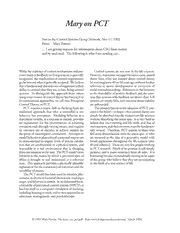
Mary on PCT PDF
Preview Mary on PCT
Mary on PCT Post to the Control Systems Group Network, Nov 11, 1992 From: Mary Powers ... I am getting requests for information about CSG from netters and by snail mail. The following is what I am sending out... While the existence of control mechanisms and pro- Control systems are not new in the life sciences. cesses (such as feedback) in living systems is generally However, numerous misapprehensions exist, passed recognized, the implications of control organization down from what was learned about control theory go far beyond what is generally accepted. We believe by non-engineers 40 or 50 years ago without further that a fundamental characteristic of organisms is their reference to newer developments or correction of ability to control; that they are, in fact, living control initial misunderstandings. References in the literature systems. To distinguish this approach from others to the desirability of positive feedback and the asser- using some version of control theory but forcing it to tion that systems with feedback are slower than S-R fit conventional approaches, we call ours Perceptual systems are simply false, and concerns about stability Control Theory, or PCT. are unfounded. PCT requires a major shift in thinking from the The primary barrier to the adoption of PCT con- traditional approach: that what is controlled is not cepts is the belief—or hope—that control theory can behavior, but perception. Modeling behavior as a simply be absorbed into the mainstream life sciences dependent variable, as a response to stimuli, provides without disturbing the status quo. It is very hard to no explanation for the phenomenon of achieving believe that one’s training and life work, and that of consistent ends through varying means, and requires one’s mentors, and their mentors, must be fundamen- an extensive use of statistics to achieve modest (to tally revised. Therefore, PCT appeals to those who the point of meaningless) correlations. Attempts to feel some dissatisfaction with the status quo, or who model behavior as planned and computed output can are attracted to the idea of a generative model with be demonstrated to require levels of precise calcula- broad application throughout the life sciences (plus tion that are unobtainable in a physical system, and AI and robotics). There are very few people working impossible in a real environment that is changing in PCT research. Much of its promise is still simply from one moment to the next. The PCT model views promise, and it meets resistance from all sides. It is behavior as the means by which a perceived state of frustrating but also tremendously exciting to be a part affairs is brought to and maintained at a reference of the group who believe that they are participating state. This approach provides a physically plausible in the birth of a true science of life. explanation for the consistency of outcomes and the variability of means. The PCT model has been used to simulate phe- nomena as diverse as bacterial chemotaxis, tracking a target, and behavior in crowds. In its elaborated form, a hierarchy of perceptual control systems (HPCT), it has lent itself to a computer simulation of tracking, including learning to track, and to new approaches to education, management, and psychotherapy. © 1992 Mary Powers File mary_on_pct.pdf from www.livingcontrolsystems.com March 2004
